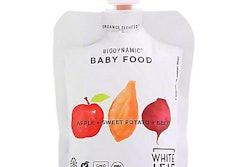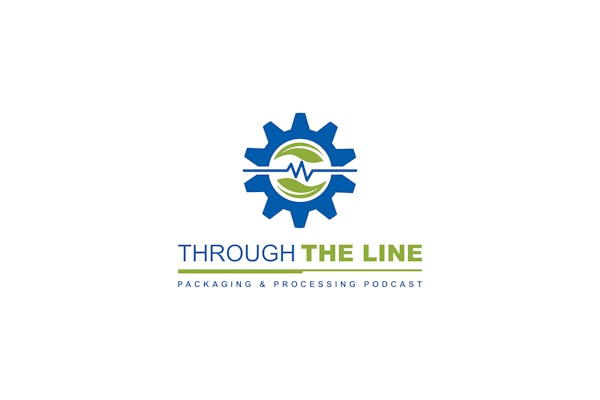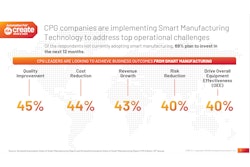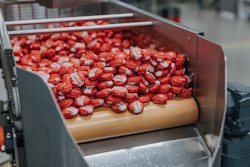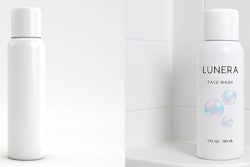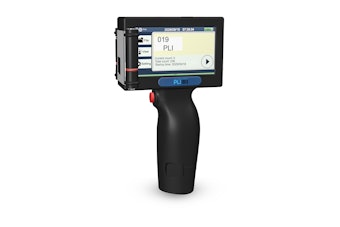Day one of the Sustainability in Packaging virtual event covered a range of topics such as the impact of COVID on the packaging industry (and plans for post-COVID), plastics recycling, and packaging design for e-commerce.
Here are just some of the highlights from today’s content:
Impact of COVID on Packaging Industry
Adam Page, Director of Research and Reports at Smithers, said that though there was a dip in the global packaging market forecast in 2020, there is a current rebound underway with the expectation of a return to former projected growth by 2024.
The pandemic has accelerated pre-existing trends such as fast-tracking e-commerce usage; shifted consumer behavior in ways such as increasing consumption of pre-packaged food products; and disrupted supply chains with material shortages, shipping delays, and resultant increases in material prices.
And when looking at post-COVID trends, Page said sustainability is still a key driver (particularly in the area of lightweighting), and e-commerce brings big opportunities to the areas of transit and protective packaging. E-commerce has seen a ten-year growth in three-month’s time during the pandemic, and Nielsen forecasts 70% of global consumers will do their grocery shopping online by 2024. With this rise in e-commerce comes a need for additional packaging to enable products to enter a more complex distribution chain.
See this video: E-commerce 2020 in less than 20 minutes
Page also said there is investment and increase in collection and recycling, as well as investment in simplifying multi-material laminates and developing high-barrier mono-material solutions. Chemical recycling in the US is another emerging market (one that is discussed in more detail in the next section).
Package design will continue to be influenced by consumer trends, particularly the demand for convenience with easy-to-open and resealable closures. Flexible packaging is seen replacing glass bottles and metal packaging due to lightweighting, and there is an expectation to see a growth in mono-material pouches.
Page points out that these trends and developments are creating new business models in packaging:
· Vertical development of the supply chain
· New materials
· Predictive maintenance and smart packaging
· Driven by e-commerce and big data
· Package design to include digital printing, 3D printing and smart packaging.
Plastics: Advanced Recycling
According to Plastic Energy (the only company to have validated and certified the Plastic2Plastic process for a circular economy of plastics), the problem isn’t plastics, but plastic waste. Plastic use has increased twentyfold in the last 50 years, and the global recycling rate is only 14% (less in the US). Plastic Energy has created a circular economy solution by chemically converting end-of-life plastic waste that can’t be recycled, into hydrocarbon oil (TACOIL), which is then used to create clean recycled food-grade plastics. Only plastics that can’t be mechanically recycled are sent through this process – currently most is flexible packaging – so TACOIL processing is used to compliment mechanical recycling, which should be the first step.
See this 7 minute video: Syngas Plasma Gasification: A Step Toward the Circular Economy
The company currently has two plants in Spain, with new plants opening in The Netherlands (2022), Malaysia (2023) and five plants to be constructed in Indonesia. By 2025, Plastic Energy will convert at least 300,000 tons of low-grade plastic waste into feedstock for new plastic manufacturing.
Packaging Design and E-Commerce
This panel led by Scott Byrne of Sonoco, Melissa Dandy of Johnson & Johnson, Brent Lindberg of Fuseneo, and Kelly Murosky of Seventh Generation, discussed considerations of designing for e-commerce. Dandy and Lindberg were both recently involved in the creation of the E-Commerce Packaging Council.
For brands who don’t know where to start with e-commerce, Dandy suggests mapping the process from the consumer’s point of view, as there are various current paths through omni-channel versus traditional retail store selling.
There is one main guideline for secondary packaging available to e-commerce retailers right now, which was created by Amazon in conjunction with ISTA. This guideline consists of two key tests, one for shipping e-commerce specific packaging (Ship in Own Container, or SIOC test), and the ISTA6 Overbox testing, for single items or co-mingled shipping.
Read: Lenox Optimizes Wine Glass Packaging for Amazon Shipping
There is a challenge designing for the various channels, with no current standards other than the aforementioned tests. And Dandy mentioned costs associated with prep-fees, or packaging that is not ideally suited to e-commerce shipping, but said that consumer demand for a product sometimes means offering it online regardless of fees, until resources become available to update the product packaging for e-commerce. She also said there is an industry shift as brands are now beginning to design packaging with preparation for omnichannel sales at the fore.





